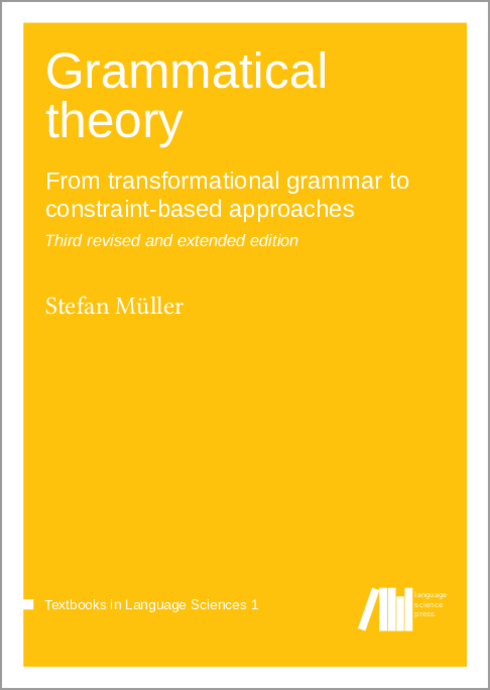
Grammatical theory: From transformational grammar to constraint-based approaches
No ratings
Stefan Müller, Berlin, Germany
Copyright Year: 2019
Publisher: Language Science Press
Language: English
Formats Available
Conditions of Use
![]() Attribution
Attribution
CC BY
Table of Contents
- 1 Introduction and basic terms
- 2 Phrase structure grammar
- 3 Transformational Grammar - Government & Binding
- 4 Transformational Grammar - Minimalism
- 5 Generalized Phrase Structure Grammar
- 6 Feature descriptions
- 7 Lexical Functional Grammar
- 8 Categorical Grammar
- 9 Head-Driven Phrase Structure Grammar
- 10 Construction Grammar
- 11 Dependency Grammar
- 12 Tree Adjoining Grammar
- 13 The Innateness of linguistic knowledge
- 14 Generative-enumerative vs. model-theoretic approaches
- 15 The competence/performance distinction
- 16 Language acquisition
- 17 Generative capacity and grammar formalisms
- 18 Binary branching, locality, and recursion
- 19 Empty elements
- 20 Extraction, scrambling, and passive: one or several descriptive devices?
- 21 Phrasal vs. lexical analyses
- 22 Structure, potential structure and underspecification
- 23 Universal Grammar and comparative linguistics without UG
- 24 Conclusion
Ancillary Material
Submit ancillary resourceAbout the Book
This book introduces formal grammar theories that play a role in current linguistic theorizing (Phrase Structure Grammar, Transformational Grammar/Government & Binding, Generalized Phrase Structure Grammar, Lexical Functional Grammar, Categorial Grammar, Head-Driven Phrase Structure Grammar, Construction Grammar, Tree Adjoining Grammar). The key assumptions are explained and it is shown how the respective theory treats arguments and adjuncts, the active/passive alternation, local reorderings, verb placement, and fronting of constituents over long distances. The analyses are explained with German as the object language.
The second part of the book compares these approaches with respect to their predictions regarding language acquisition and psycholinguistic plausibility. The nativism hypothesis, which assumes that humans posses genetically determined innate language-specific knowledge, is critically examined and alternative models of language acquisition are discussed. The second part then addresses controversial issues of current theory building such as the question of flat or binary branching structures being more appropriate, the question whether constructions should be treated on the phrasal or the lexical level, and the question whether abstract, non-visible entities should play a role in syntactic analyses. It is shown that the analyses suggested in the respective frameworks are often translatable into each other. The book closes with a chapter showing how properties common to all languages or to certain classes of languages can be captured.
About the Contributors
Author
Stefan Müller studied Computer Science, Computational Linguistics and Linguistics at the Humboldt University at Berlin and in Edinburgh. He worked at the German Research Center of Artificial Intelligence (DFKI) in Saarbrücken and for the company Interice. He worked as acting chair for German and Computational Linguistics in Jena and for Theoretical Computational Linguistics in Potsdam. He had an assistant professorship in Bremen for theoretical linguistics and computational linguistics, a full professorship for German and General Linguistics at the Freie Universität Berlin and is now professor for German language with specialization in syntax at the Humboldt-Universität zu Berlin.
